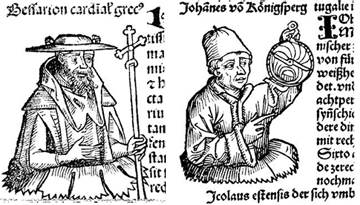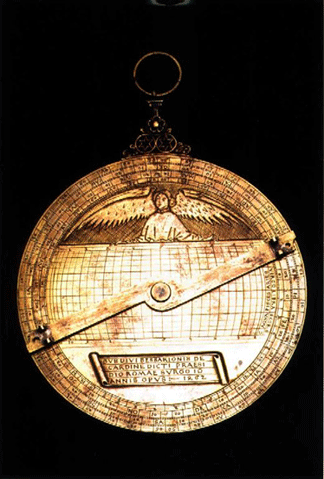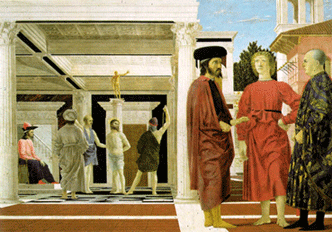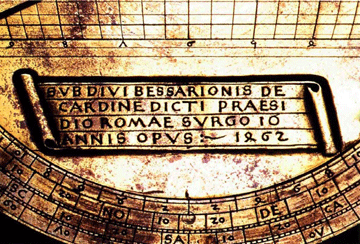
AN INTRODUCTION TO THE DE REGIO MONTE CODE, CARDINAL BESSARION’S AGENDA, AND PIERO DELLA FRANCESCA’S ENIGMA
[The noted historian of Islamic science, David A. King, recently retired from his position as Professor of the History of Science at Frankfurt University, has published a new book on two of the most remarkable objects surviving from the Renaissance, one an astrolabe and the other a painting. The connection between the two is described in detail in his new book Astrolabes and Angels, Epigrams and Enigmas – From Regiomontanus’ Acrostic for Cardinal Bessarion to Piero della Francesca’s Flagellation of Christ, Stuttgart: Franz Steiner, 2007. An associated website is http://web.uni-frankfurt.de/fb13/ign/Code.htm.]
Only recently have we achieved a better understanding of two monuments to the intellectual genius of the Renaissance, both of which have caused scholars a lot of trouble over several decades. As it happens, the two are intimately related.

The back of the astrolabe made by Regiomontanus for Cardinal Bessarion, with an inscription or epigram and the image of an angel.
One is an astrolabe, presented to the ageing Greek Cardinal Bessarion in Rome, 1462, by his new protégé, the young German astronomer Regiomontanus. This is engraved with the image of an angel and an ingenious Latin epigram that is geometrically arranged. Eight hidden vertical axes of an acrostic contain all manner of hidden messages that would have especially pleased the Cardinal. The angel is Bessarion, but not the Cardinal. There are several word plays on the Latin word cardo, meaning “hinge, axis or poleâ€. In brief, two astrolabes come together in one, two poems, two languages, two Bessarions, two men who used the name Ioannes, all come together in one. However, when he saw the epigram, Bessarion must very quickly have noticed something about the letters that Regiomontanus cannot possibly have intended, namely, that – mainly by chance – groups of them reminded him of various people who were involved in the Passion of Christ, the Fall of Byzantium, or in his own political, intellectual and personal agendas.

The magnificent painting of Piero della Francesca. Over 40 hypotheses have been proposed for the identity of the three men on the right. The rather angelic young man in red is Regiomontanus.
The other monument is a painting, “The Flagellation of Christâ€, the most enigmatic and controversial work of the leading mathematician-artist of 15th-century Italy, Piero della Francesca. The symbolic flagellation with five persons takes place in the background on the left, and in the foreground on the right, there are three “modern†figures: a Greek ambassador, a young man with a rather angelic face, and an Italian dignitary. These images are not portraits; otherwise they surely could have been identified. In the past 150 years over 40 attempts have been made to identify them, with wildly different results. In fact, until recently, nobody had ever convincingly explained who or what these three persons represent. This is because the key to the “programme†behind the painting is in the angel and the letters of the epigram on Regiomontanus’ astrolabe.

The epigram of Regiomontanus for Cardinal Bessarion is an acrostic with eight vertical axes and, at the same time, the pre-text for a remarkable painting.
The geometry and symmetry of the painting reflect those of the epigram, and the letters of the epigram – read from left to right but also from right to left – suggest double or multiple identities for each and every one of the nine images – eight persons and one classical god – that are found in the painting. It is not surprising that we can find the letters for these names amongst the letters in the epigram; what is surprising is that the names we can find for the first five spaces correspond to the five persons and one classical god in the Flagellation scene, with a selection of candidates for the three men on the right. The bearded man is Bessarion, but the image shows him more as he might have looked in Florence in 1439 before he became a Cardinal. Nevertheless the image does represent the Cardinal because the angelic figure in cardinal red beside him represents the young Regiomontanus, whom the Cardinal had brought to Italy in late 1461. However, the image representing the young German embodies five other persons, three who had died recently and two who were long dead, who were also close to Bessarion. In the complex iconography there is now a play on the Italian word cardo, meaning “thistleâ€.
The painting once bore a title, long since removed, namely, the Biblical phrase Convenerunt in unum, “they came together in oneâ€, whose basic meaning applies equally well to the astrolabe. Somehow, Bessarion and Regiomontanus, maybe with the help of some friends, developed the idea for this remarkable painting in which over twenty people and four classical gods come together in three different scenes at three different times, all coming together in one in spectacular perspective.
David A. King